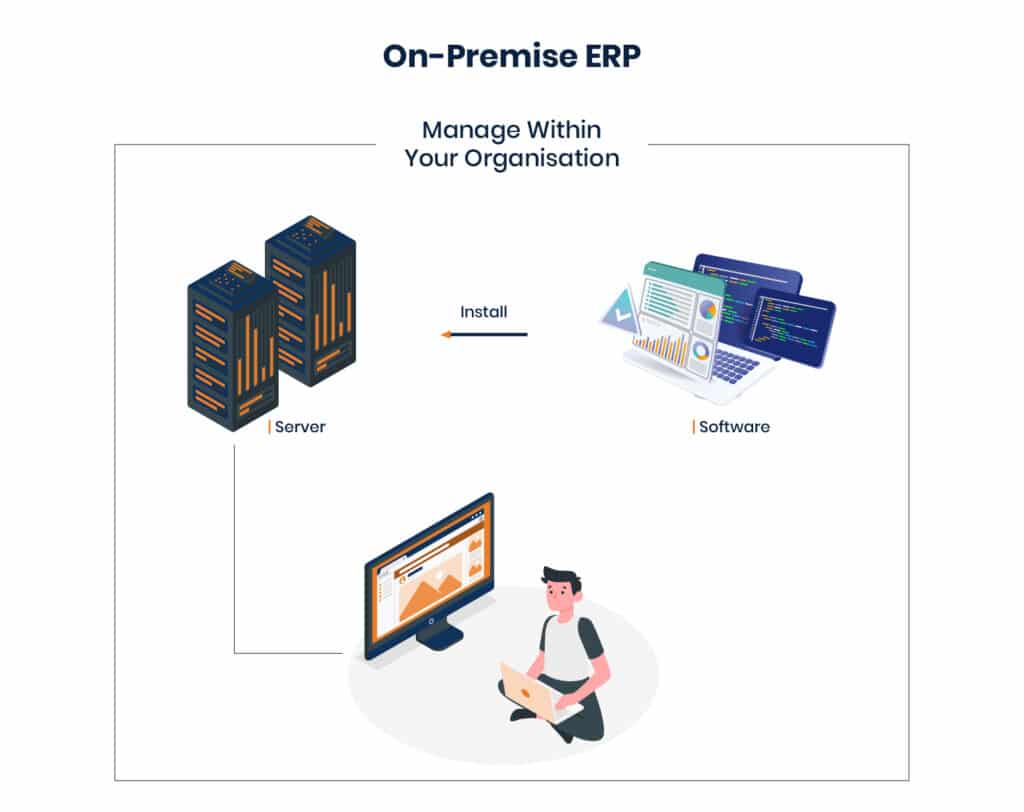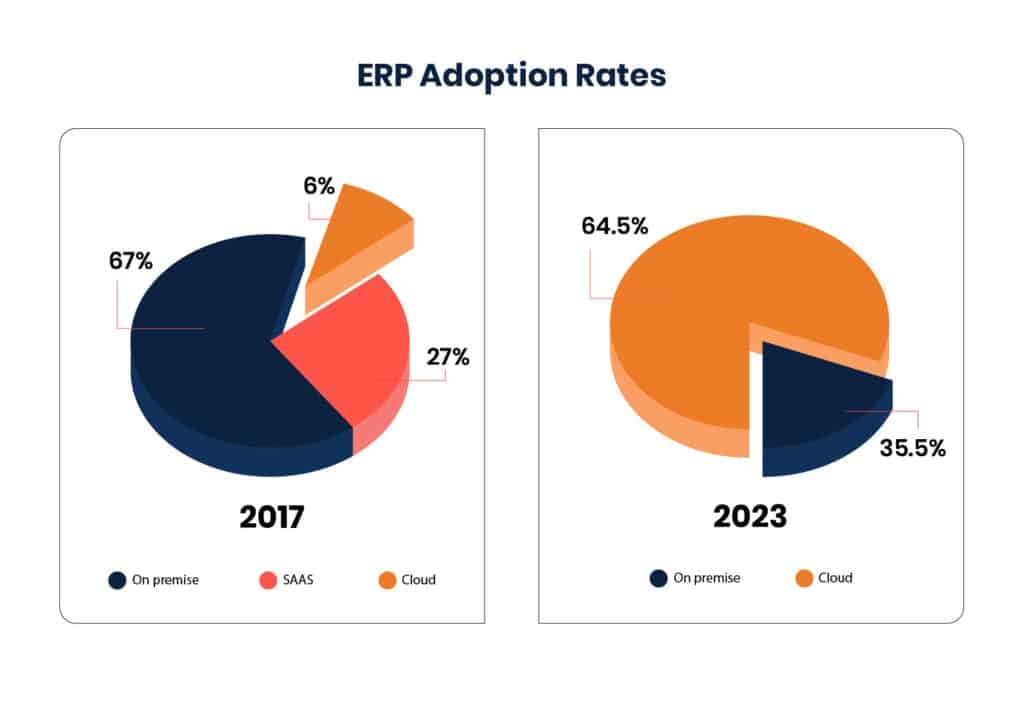At some point, every business outgrows the tools it started with. Spreadsheets, standalone software, and disconnected workflows begin to slow down operations, making management more challenging. Information gets siloed, processes become harder to track, and growth plans start to feel restricted. And that is where systems, whether ERP on cloud or on premise, come into play. They serve as a unified platform that connects site operations, procurement, finance, HR, and management into a single, integrated workflow.
But once you’ve decided to go with an ERP system, a critical question follows:
Where should your ERP actually live in your software architecture? Should you run it on your own servers, or let someone else host and manage it in the cloud? This decision goes beyond IT preferences. It shapes how your teams operate, how quickly you can adapt, and how much you need to invest, not just at the start, but as your business evolves.
This guide explores the key differences between ERP on cloud vs on premise, highlighting the factors that really matter; be it as operational control, cost, scalability, security and long-term suitability. By the end of this article, you’ll be better equipped to decide which option aligns with your organisation’s infrastructure and future growth plans.
What is Cloud ERP?

Cloud ERP runs on infrastructure maintained by the vendor. It is accessed through the internet, typically via web browsers or mobile apps, allowing central and site teams to work from anywhere without managing internal hardware or networks.
- Hosting: Vendor-managed, hosted in remote data centers.
- Access: Secure, browser-based access from office or site locations.
- Updates: Handled by the vendor, with automatic rollouts.
- Costs: Subscription-based (monthly or annual), often under operational expenditure (OPEX).
The appeal of Cloud ERP for construction lies in its flexibility. Firms can quickly scale up for new projects, coordinate remote site teams, or integrate subcontractor management modules without additional IT infrastructure. System performance, uptime, and security are handled by the vendor, freeing up your team to focus on site execution, procurement, and project delivery.
What is On-Premise ERP?

On-Premises ERP is installed on your organisation’s servers, located physically at the head office or regional data centres. It requires careful implementation to ensure seamless integration with project management tools, procurement platforms, and financial systems. Your IT team is responsible for setup, ongoing support, and system security.
- Hosting: Controlled internally on company-owned infrastructure.
- Access: Primarily within the organisation’s local network; field access requires secure configurations.
- Updates: Managed manually by your IT team, allowing control over upgrade timelines and system customisations.
- Costs: Typically, a large upfront investment in licenses and hardware, with ongoing maintenance costs.
This model offers direct control over construction data, document management, and system integration. For firms with strict regulatory compliance needs ( for example, government contracts), existing IT investments, or highly customised workflows for estimation, project tracking, and billing, on-premise ERP provides the tailored environment necessary to meet those demands.
Key differences between ERP on Cloud vs On Premise
Understanding the key differences can help you choose the system that best supports your construction operations and growth.

1. Deployment and accessibility
- Cloud ERP provides rapid deployment, often within weeks. Its internet-based access supports dispersed site teams, regional offices, and consultants whether in the field, on-site trailers, or working from client offices.
- On-Premise ERP requires a longer setup period, potentially months, due to hardware installations, internal configurations, and testing. However, it offers full customisation and tighter integration with construction-specific tools like BIM, scheduling software, and vendor management systems.
2. Cost model
- Cloud ERP operates on an operating expenditure (OPEX) model. Subscription fees typically include maintenance, updates, and hosting. This allows predictable budgeting, especially for growing firms managing multiple ongoing projects.
- On-Premise ERP follows a capital expenditure (CAPEX) model. There’s a high upfront cost for hardware and licenses, followed by long-term support and upgrade costs. This can be more viable for large firms that want to amortize investments over time.
Some organisations prefer predictable recurring payments, while others opt for upfront investment with lower ongoing costs. The financial strategy depends on how your organisation handles budgeting and long-term infrastructure planning.
3. Control and customisation
- Cloud ERP is often configurable but may have limitations in deeply customised workflows. It suits standardised processes in procurement, budgeting, and HR, but may require additional APIs or middleware for complex project-specific integrations.
- On-Premise ERP enables deeper customisation ideal for large construction enterprises that need specific modules for things like equipment tracking, risk assessments, or specialised billing tied to contract types (for example, EPC or DBB).
4. Scalability
- Cloud ERP scales easily. Whether onboarding 5 new project teams or expanding to another country, scaling requires no physical infrastructure upgrades.
- On-Premise ERP scalability depends on internal IT capabilities. Adding new offices or users means increasing server capacity and managing configurations manually.
5. Security and compliance
- Cloud ERP providers implement strong security protocols, including encryption, multi-factor authentication, and disaster recovery. Many providers comply with global construction and data standards like ISO 27001 or SOC or GDPR.
- On-Premise ERP gives full control over security policies, user access, and data storage critical for construction firms handling sensitive blueprints, government tenders, or legally sensitive project data.
The right choice here depends on the regulatory landscape of your industry and your organisation’s appetite for managing security directly.
6. Maintenance and updates
- Cloud ERP shifts all maintenance to the vendor. Updates and patches are applied automatically, ensuring your system stays secure and functional without tying up internal resources, crucial when managing active sites and tight schedules.
- On-Premise ERP requires internal oversight for every update. Construction firms often defer these to avoid disrupting integrated systems like procurement or project controls, which can leave the ERP outdated or exposed to risks.
7. Performance and reliability
- Cloud ERP runs on high-availability infrastructure with built-in redundancy. For construction businesses spread across regions, this ensures consistent access and uptime, even during peak project phases.
- On-Premise ERP depends on your own hardware and recovery plans. Without enterprise-grade IT support, any server issue can delay site reporting, approvals, or cost tracking, directly impacting project timelines.
Which option suits construction firms best?
Choosing the right software for your construction business is a critical decision especially given the industry’s complexity and evolving demands. While cloud-based ERP solutions offer significant benefits, the best fit ultimately depends on your organisation’s unique needs.

If you see there has been a significant difference in the adoption rates of various types of ERP software to date. However, you can choose the one that best suits your organisation based on a few key considerations outlined below.
Choose Cloud ERP if:
- You’re growing fast and want to scale across new locations without IT friction.
- You need mobile access for field engineers, site supervisors, or remote teams.
- You want to reduce upfront costs and spread-out expenses.
- You prefer vendor-managed security, performance, and uptime.
Choose On-Premise ERP if:
- You work on government or high-compliance projects where data control is critical.
- You already have significant IT infrastructure and in-house expertise.
- You require extensive customisation or integration with older systems.
- You prefer to capitalise software costs upfront instead of ongoing subscriptions.
Choosing ERP That Matches Business Reality
It’s a strategic decision that shapes how you deliver projects, manage complexity, and build smarter in a market that rewards efficiency and foresight. Whichever model you choose, the goal remains the same: more visibility, more control, and fewer surprises on site.
Evaluate where your organisation stands today and where you’re headed. The ERP model you adopt should support that trajectory without introducing unnecessary friction or limitations.
Xpedeon ERP is a complete solution built for the engineering and construction industries. It supports 360 digitalisation by connecting all parts of a project. This includes design, procurement, delivery, finance and compliance. Everything runs through one integrated platform.
To see such a platform in action, get in touch today.
Share this Post

